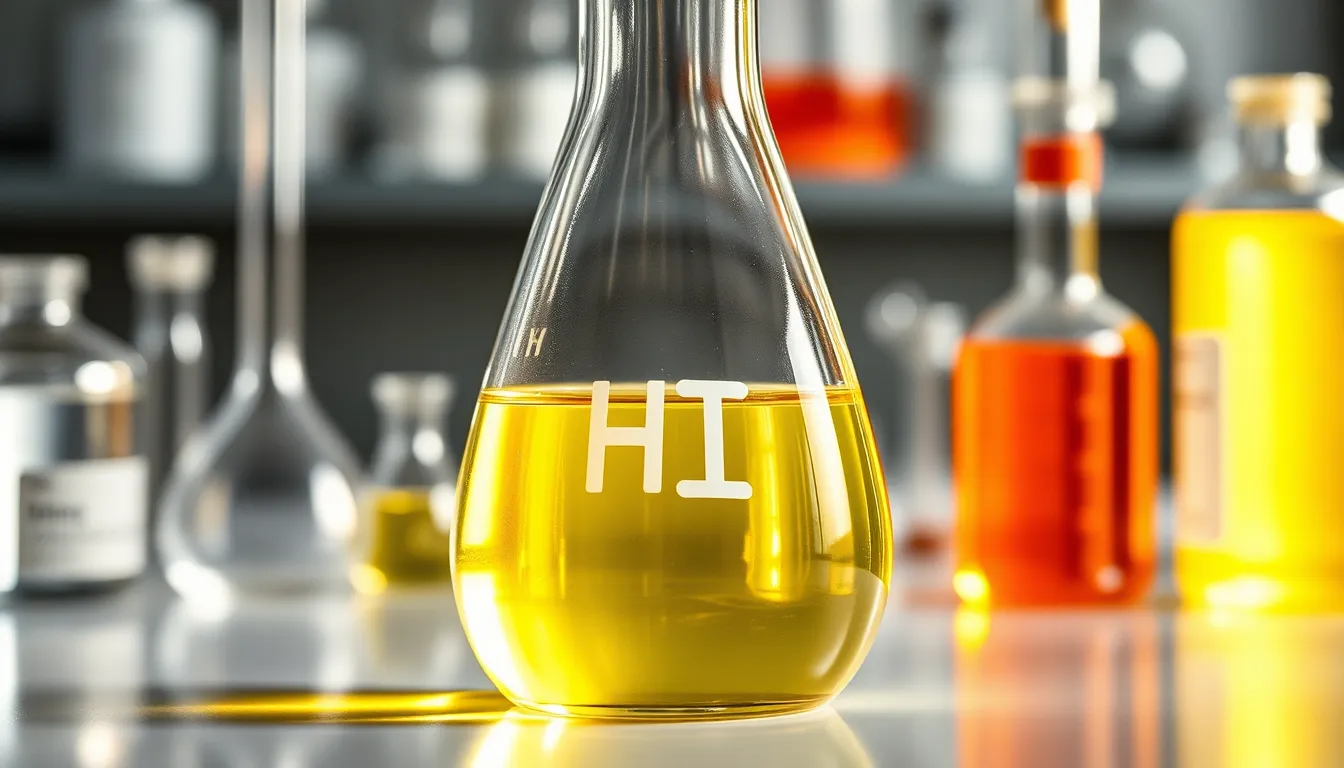Hydroiodic acid (HI) often sparks interest in the world of chemistry due to its unique properties. As a binary acid formed from hydrogen and iodine, it raises questions about its strength compared to other acids. Understanding whether HI qualifies as a strong acid is crucial for students, chemists, and anyone curious about chemical reactions.
In the realm of acids, strength is determined by how completely an acid dissociates in water. HI’s behavior in aqueous solutions can shed light on its classification and importance in various chemical processes. This article dives into the characteristics of hydroiodic acid, exploring its dissociation, applications, and implications in both laboratory and industrial settings.
Table of Contents
ToggleUnderstanding Acids and Bases
Acids and bases play a crucial role in chemistry, defined by their unique properties and behavior. Acids increase the concentration of hydrogen ions (H⁺) in aqueous solutions, while bases increase the concentration of hydroxide ions (OH⁻). The pH scale measures the acidity or basicity of a solution, ranging from 0 to 14. A pH below 7 indicates acidity, while a pH above 7 indicates basicity.
Strong acids, like hydroiodic acid (HI), completely dissociate in water, releasing all of their H⁺ ions. Weak acids, in contrast, partially dissociate, resulting in a lower concentration of free H⁺ ions in solution. Common examples of strong acids include hydrochloric acid (HCl) and sulfuric acid (H₂SO₄), which, similar to HI, exhibit a high capacity to donate protons.
The strength of an acid is determined by its dissociation constant (Ka), a measure of the acid’s ability to release H⁺ ions. A higher Ka value indicates a stronger acid. Hydroiodic acid has a high Ka, confirming its classification as a strong acid.
Acids and bases interact in neutralization reactions, producing water and salts. This reaction forms the basis for many applications in chemical industries, including the production of fertilizers, pharmaceuticals, and food processing. Understanding the behavior of strong acids like HI is vital for safe handling and effective use in laboratory and industrial settings.
The Nature of Hydroiodic Acid (HI)

Hydroiodic acid (HI) is a powerful strong acid, characterized by its complete dissociation in water. Understanding its properties and formation provides insight into its applications and behavior in various environments.
Physical and Chemical Properties
Hydroiodic acid appears as a colorless to yellowish liquid with a pungent odor. It has a high boiling point of approximately 127 °C and a density of 1.70 g/cm³. HI’s strong acidic nature is evident, as it completely dissociates in aqueous solutions to yield hydrogen ions (H⁺) and iodide ions (I⁻). This complete ionization distinguishes it from weak acids, which only partially dissociate.
HI exhibits significant reactivity with bases, leading to neutralization reactions that produce salt and water. It effectively reacts with metals, reducing agents, and organic compounds. The dissociation constant (Ka) for hydroiodic acid is exceedingly high, indicating its strong acidic strength when placed on the pH scale.
Formation and Concentration
Hydroiodic acid forms when iodine gas reacts with hydrogen gas, resulting in the equation ( text{H}_2 + text{I}_2 rightarrow 2text{HI} ). This reaction typically occurs under heat or in the presence of catalysts.
Concentrated solutions of hydroiodic acid typically contain 57% HI by weight, which corresponds to a high molarity of approximately 8.3 M. This concentration offers practical applications in laboratories and industry, including synthesis reactions and as a reagent in chemical analysis. The stability and potency of concentrated HI make it crucial in organic chemistry and various industrial processes.
Acid Strength Comparison
Acid strength comparison involves analyzing the dissociation properties of various acids in aqueous solutions. The behavior of hydroiodic acid (HI) serves as a benchmark for understanding strong acids.
Measuring Acid Strength
Acid strength is quantifiable through its dissociation constant (Ka) and pH value. Strong acids, including HI, fully dissociate in water, leading to a low pH, typically below 3. Ka values indicate the degree of ionization; a higher Ka reflects a stronger acid. For HI, the Ka is significantly high, confirming its strong acid classification. The extent of dissociation can be measured through titration methods, revealing the effective concentration of hydrogen ions produced in a solution.
Comparison with Other Strong Acids
Strong acids are categorized based on their ability to dissociate in water. Hydroiodic acid (HI) is one of the strongest, along with hydrochloric acid (HCl) and hydrobromic acid (HBr). The following table summarizes key characteristics:
| Acid | Dissociation in Water | Ka Value | pH Range |
|---|---|---|---|
| HI | Complete | Very high | < 1 |
| HCl | Complete | High | < 1 |
| HBr | Complete | High | < 1 |
| Acetic Acid | Partial | Low | 4.76 |
HI’s complete dissociation results in a higher concentration of hydrogen ions compared to weak acids like acetic acid. While HCl and HBr are comparable in strength, HI’s superior dissociation makes it essential in industrial applications requiring strong acidic conditions.
Applications of Hydroiodic Acid
Hydroiodic acid (HI) has significant applications in various industries and laboratories due to its strong acidic properties and reactivity. Its characteristics make it an essential reagent for numerous chemical processes.
Industrial Uses
- Synthesis of Iodine Compounds: HI plays a critical role in producing iodine-containing compounds, such as iodides used in pharmaceuticals and agrochemicals.
- Catalyst in Organic Reactions: HI serves as a catalyst in several organic reactions, including the synthesis of alcohols and ethers from alkyl halides.
- Hydrogenation Reactions: HI facilitates hydrogenation processes, enabling the conversion of unsaturated hydrocarbons into saturated compounds, which are vital for producing various petrochemicals.
- Preparation of Reducing Agents: HI is used in manufacturing reducing agents, such as sodium hydrosulfite, which find applications in textile and paper industries.
- Chemical Manufacturing: HI is utilized in processes to produce acetic acid and other organic compounds, showcasing its versatility in industrial applications.
Laboratory Applications
- Reagent in Titrations: HI is employed as a strong acid in titration experiments to determine the concentration of bases through neutralization reactions.
- Preparation of Iodine Solutions: HI is used to prepare iodine solutions for various biochemical analyses and applications, such as staining in microscopy.
- Cleavage Reactions: HI aids in cleavage reactions in organic chemistry, helping break down carbon-carbon bonds and facilitating material synthesis.
- Synthesis of Amines: HI is instrumental in amine synthesis, enabling the conversion of alkyl halides into primary, secondary, and tertiary amines through nucleophilic substitution.
- Analytical Chemistry: HI acts as a strong acid in analytical procedures, ensuring accurate pH levels for optimal reactivity and results in qualitative analysis.
Hydroiodic acid stands out as a strong acid due to its complete dissociation in aqueous solutions. This characteristic not only defines its strength but also underlines its importance in various chemical applications. Its high Ka value and ability to yield significant concentrations of hydrogen ions make it a crucial player in both laboratory and industrial settings.
From organic synthesis to chemical analysis, HI’s versatility is evident across multiple fields. Understanding its properties and safe handling is essential for anyone working with strong acids. With its unique attributes, hydroiodic acid continues to be an invaluable resource in advancing chemical processes and innovations.









